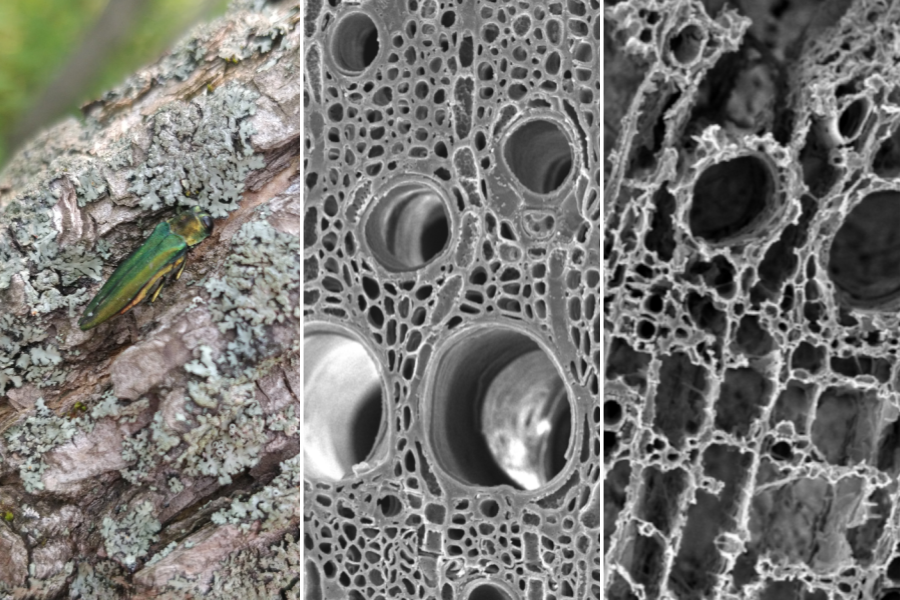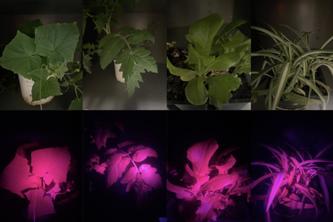Fungi contribute to loss of structural strength in trees attacked by emerald ash borer

MINNEAPOLIS/ST. PAUL (04/04/2023) — Since emerald ash borer (EAB) was first detected in North America in 2002, the invasive beetle has killed hundreds of millions of mature ash trees. After an attack, branches and trunks weaken and the trees become more likely to fall. Though this degradation has historically been attributed to damage from the beetles, new research from the University of Minnesota confirms that fungi play a significant role in the process.
Researchers from the Department of Plant Pathology and the Minnesota Invasive Terrestrial Plants and Pests Center recently published their findings in the journal Forests.
“When ash trees get attacked by the emerald ash borer they lose structural integrity quickly, limbs and the main stems can fail and the tree becomes hazardous. We now know the identity of several of these very aggressive pioneer species of decay fungi that are responsible,” said Robert Blanchette, a professor in the Department of Plant Pathology.
The study was conducted by testing wood decay fungi on ash wood samples under laboratory conditions using fungal species that were previously obtained from beetle galleries. By learning how much wood degradation these fungi can produce in a short period of time on ash wood, researchers could infer the role they play in the loss of structural strength of beetle-attacked trees.
The researchers found:
- Several aggressive pioneer species of white rot fungi associated with EAB galleries caused extensive degradation of wood cell walls.
- The wood samples treated with decay fungi experienced a significant loss of biomass. Significant structural damage of wood cells was documented using scanning electron microscopy.
- Since some very aggressive decay fungi associated with EAB galleries were able to produce an important loss of wood structural strength in a relatively short period of time during this study, researchers concluded these fungi likely play a major role in contributing to the loss of wood integrity and hazardous tree conditions after EAB attack.
“It is still not clear how these fungi get involved with EAB as the beetle is not specialized in carrying fungal spores, but our previous studies show that these fungi are in fact associated with EAB galleries. Based on that and the extensive decay ability some of the fungi showed during this study, it is clear that they can greatly contribute to the loss of structural strength observed on EAB-attacked trees,” said first author Sofía Simeto, a graduate student in the Department of Plant Pathology.
These findings help land managers, municipalities and property owners better understand what happens to the trees after EAB attack and demonstrate the need to remove EAB-affected trees before these aggressive decay fungi become established. Ash trees left standing without treatment after EAB attack will lose their structural integrity and rapidly become hazardous and subject to branch, limb and trunk failure. These findings will help stakeholders make safer decisions while working with infected trees.
This research was funded by the Minnesota Invasive Terrestrial Plants and Pests Center (supported by the Minnesota Environment and Natural Resources Trust Fund as recommended by the Legislative-Citizen Commission on Minnesota Resources) and USDA Hatch project MIN22-089.
About the Minnesota Invasive Terrestrial Plants and Pests Center
The Minnesota Invasive Terrestrial Plants and Pests Center (MITPPC) was founded by the Minnesota Legislature to research the prevention, detection and control of terrestrial invasive species. MITPPC researchers use transformative science to prevent and minimize the threats posed by land-based invasive plants, pathogens, and pests. Founded in 2015, MITPPC is the only research center of its kind in the country, and the center's work to protect the state's native prairies, forests, wetlands, and agricultural resources benefits all of Minnesota and beyond. Learn more at mitppc.umn.edu.
About the College of Food, Agricultural and Natural Resource Sciences
The University of Minnesota’s College of Food, Agricultural and Natural Resource Sciences (CFANS) strives to inspire minds, nourish people, and sustainably enhance the natural environment. CFANS has a legacy of innovation, bringing discoveries to life through science and educating the next generation of leaders. Every day, students, faculty, and researchers use science to address the grand challenges of the world today and in the future. CFANS offers an unparalleled expanse of experiential learning opportunities for students and the community, with 12 academic departments, 10 research and outreach centers across the state, the Minnesota Landscape Arboretum, the Bell Museum of Natural History, and dozens of interdisciplinary centers. Learn more at cfans.umn.edu.
- Categories:
- Agriculture and Environment





